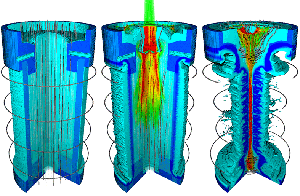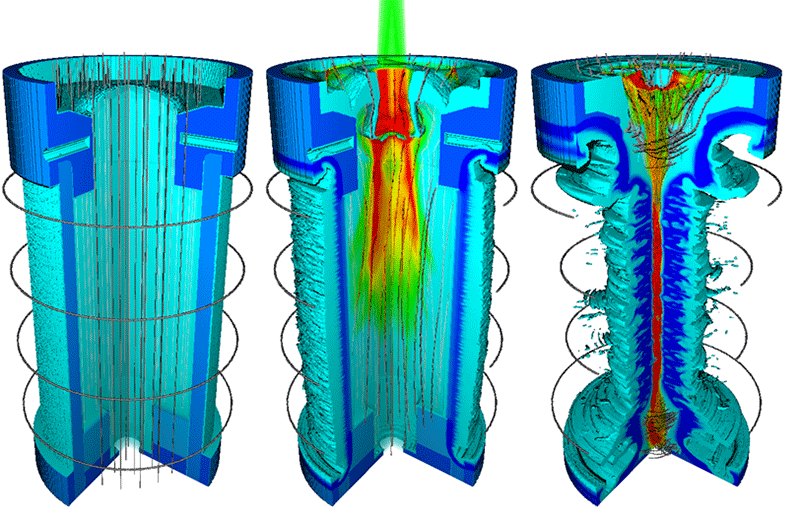Magnetic Fields Lock in the Heat for Fusion
Ever since the first successful test of a thermonuclear device in 1952, scientists have had their sights on extracting useful energy from nuclear fusion. Several laboratory approaches to doing this are underway, but all of them struggle with how to keep sufficient heat in the nuclear fuel to drive fusion reactions. Researchers at Sandia National Laboratories in New Mexico have now shown that a strategy called Magnetized Liner Inertial Fusion (MagLIF), in which a strong magnetic field is embedded in an imploding plasma of deuterium gas, is effective at retaining the heat necessary for fusion. They showed that the field increases the yield of nuclear fusion reactions by a factor of 100 compared to similar implosions performed without a field [1,2], a demonstration that confirms the validity of some of the key physics underpinning MagLIF.
The basic principles of nuclear fusion are simple. The nuclei of two hydrogen isotopes (deuterium and tritium, D+T) colliding at sufficiently high speed can fuse to form a helium ion and a neutron. This fusion reaction produces large amounts of energy that are shared by the reaction products, helium and neutrons.
Creating fusion and harnessing its energy in a laboratory setting is, however, hard to achieve. Nuclei are positively charged and their mutual repulsion prevents them from getting close enough to fuse unless they collide at extremely high speeds—on the order of 1000 km/s. To reach such high velocities, a DT gas must be heated to about 50–100 million degrees Celsius, a temperature at which the electrons are stripped from the ions and the gas becomes a plasma. This introduces yet another experimental challenge, as hot plasmas lose their energy quickly. In fact, the more heat that is supplied to a plasma, the faster it loses it.
Scientists studying fusion have developed two different approaches to keeping heat in the plasma. The first, known as magnetic fusion energy (MFE), is to embed strong magnetic fields in the plasma, which, because of the Lorentz force, causes the charged particles in the plasma to circle around the field lines instead of carrying heat outwards. The most advanced MFE device is the tokamak, which uses a large (roughly 5 tesla) magnetic field to confine a hot plasma while steadily supplying heat to compensate for energy losses. The other strategy, known as inertial confinement fusion (ICF), is to heat a small amount of dense plasma quickly enough to produce a lot of fusion reactions before the plasma cools off. The most advanced ICF scheme is laser fusion, which uses laser pulses to quickly heat and compress a small pellet made of solid DT over a time scale of roughly a few nanoseconds.
Tokamaks and laser fusion achieve plasmas with similar temperatures, but operate at opposite extremes in density and time scale. Laser fusion works at high densities (hundreds of grams of fuel per cubic centimeter) while confining the plasma for only a fraction of a nanosecond. Tokamaks operate at densities that are roughly ten to a hundred billion times smaller than those obtained in laser fusion ( ∼5×10-10g/cc), but they confine plasma heat for up to several seconds.
These two approaches are the focus of most fusion research: The International Thermonuclear Experimental Reactor (ITER), under construction in France, uses a tokamak, while the National Ignition Facility in the US is working on laser fusion. But a small number of researchers, including the Sandia scientists, are exploring schemes that use intermediate densities and time scales. The crux of this strategy, known as Magneto-Inertial Fusion (MIF), is to combine the benefits of magnetic fusion and inertial fusion by embedding magnetic fields in imploding pellets of fuel. The approach relaxes the constraints on density and time scales inherent to laser-fusion-type implosions, allowing for the flexibility to use heat sources that are slower than intense laser pulses.
In the Sandia work, this heat source comes from the compression of a cylindrical target imploded by an electromagnetic (EM) driver called the Z-machine, which stores electrical energy in a large number of capacitor banks. The researchers use the machine to drive a high (19 mega-amps) current along a centimeter-long cylindrical metal shell (a.k.a. “the liner”) that surrounds deuterium gas [3]. The high current generated in the liner produces an azimuthal magnetic field. This field then exerts an inward Lorentz force on the current in the liner, causing it to implode (Fig. 1, left). A second magnetic field, directed along the liner axis and embedded in the fuel, magnetizes the plasma and keeps heat from escaping. As the target implodes the initial embedded field (which is about 10 tesla to start) gets squeezed together with the plasma inside the target (Fig. 1, right). This occurs because the imploding plasma produces large internal currents that amplify the initial vertical field. The field strength in the imploding target can jump to thousands or even tens of thousands of tesla, large enough to further magnetize the hot deuterium and improve its heat retention.
According to numerical simulations, this approach can achieve thermonuclear temperatures of hundreds of millions degrees, even when the targets are imploded at velocities an order of magnitude slower than in laser fusion. But experimental evidence that embedded magnetic fields can significantly improve implosion performance has been hard to come by. Experiments at Sandia in the late 1970s showed that magnetic fields can increase fusion yields, but the number of nuclei that underwent fusion (about a million) was too small to be rated as a breakthrough [4]. About 30 years later, the next successful experiment occurred at the University of Rochester’s Laboratory for Laser Energetics [5]. In these experiments, millimeter-scale spherical targets filled with pure deuterium were embedded in a straight magnetic field and imploded by the OMEGA laser. As predicted by simulations, these experiments showed that magnetic fields can increase the number of fusion reactions from 10 billion (no field) to 13 billion—an approximately 30% improvement.
The new experiments from Sandia represent a dramatic improvement in performance. They show that the magnetic fields enhance fusion yields by 2 orders of magnitude. A key step to achieving these exciting results was realizing that the deuterium fuel has to be preheated with a laser right before imploding it (Fig. 1, center). Heating the fuel before compression has two major benefits. First, it enhances the plasma’s ability to freeze in magnetic flux because hot plasmas are less resistive to the electrical currents needed to amplify the field during the implosion. Second, a preheated fuel is better at retaining its energy throughout the entire implosion. This comes from the fact that magnetic fields are only effective in retaining the heat within the fuel when the fuel is hot enough to be ionized (i.e., it’s a plasma).
The Sandia researchers compared three types of implosions: no embedded magnetic field and no laser preheating; an embedded magnetic field and no laser preheating; and both an embedded magnetic field and laser preheating. Only in the third case did the fusion yields skyrocket by 2 orders of magnitude from less than ten billion fusion reactions to more than one trillion fusion reactions. This sizable improvement in fusion yield comes from the increase in the compressed fuel temperature, which tripled from about 10 million to 30 million degrees.
The prospects of commercially viable fusion energy are still uncertain and a long way from being realized. Scientists have yet to show that MagLIF, or any other approach to fusion energy, can produce a fusion energy output that exceeds the driver energy input (i.e., “energy breakeven”). While it seems likely that reaching energy breakeven with MagLIF will require an even more powerful EM driver than the existing Z-machine, the Sandia researchers can, with the existing setup, further improve the implosion performance to achieve critical physics milestones. In the meantime, these very exciting results will certainly stimulate scientists to explore new regimes in search of more attractive approaches to fusion.
This research is published in Physical Review Letters.
References
- M. R. Gomez et al., “Experimental Demonstration of Fusion-Relevant Conditions in Magnetized Liner Inertial Fusion,” Phys. Rev. Lett. 113, 155003 (2014)
- P. F. Schmit et al., “Understanding Fuel Magnetization and Mix Using Secondary Nuclear Reactions in Magneto-Inertial Fusion,” Phys. Rev. Lett. 113, 155004 (2014)
- The Sandia researchers use pure deuterium fuel as opposed to deuterium and tritium because it is easier to handle experimentally
- J. N. Olsen, M. M. Widner, J. Chang, and L. Baker, “Fuel Preconditioning Studies for e-beam Fusion Targets,” J. Appl. Phys. 50, 3224 (1979)
- P. Y. Chang et al., “Fusion Yield Enhancement in Magnetized Laser-Driven Implosions,” Phys. Rev. Lett. 107, 035006 (2011)





